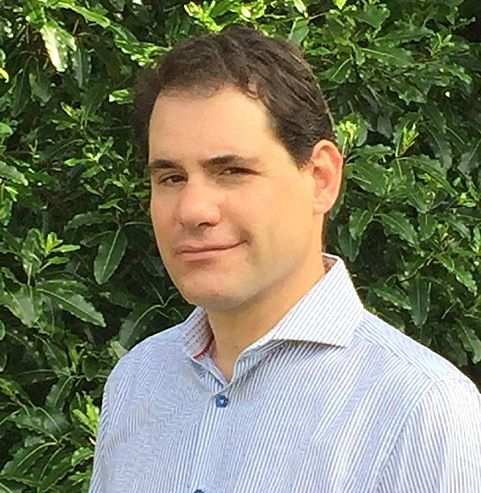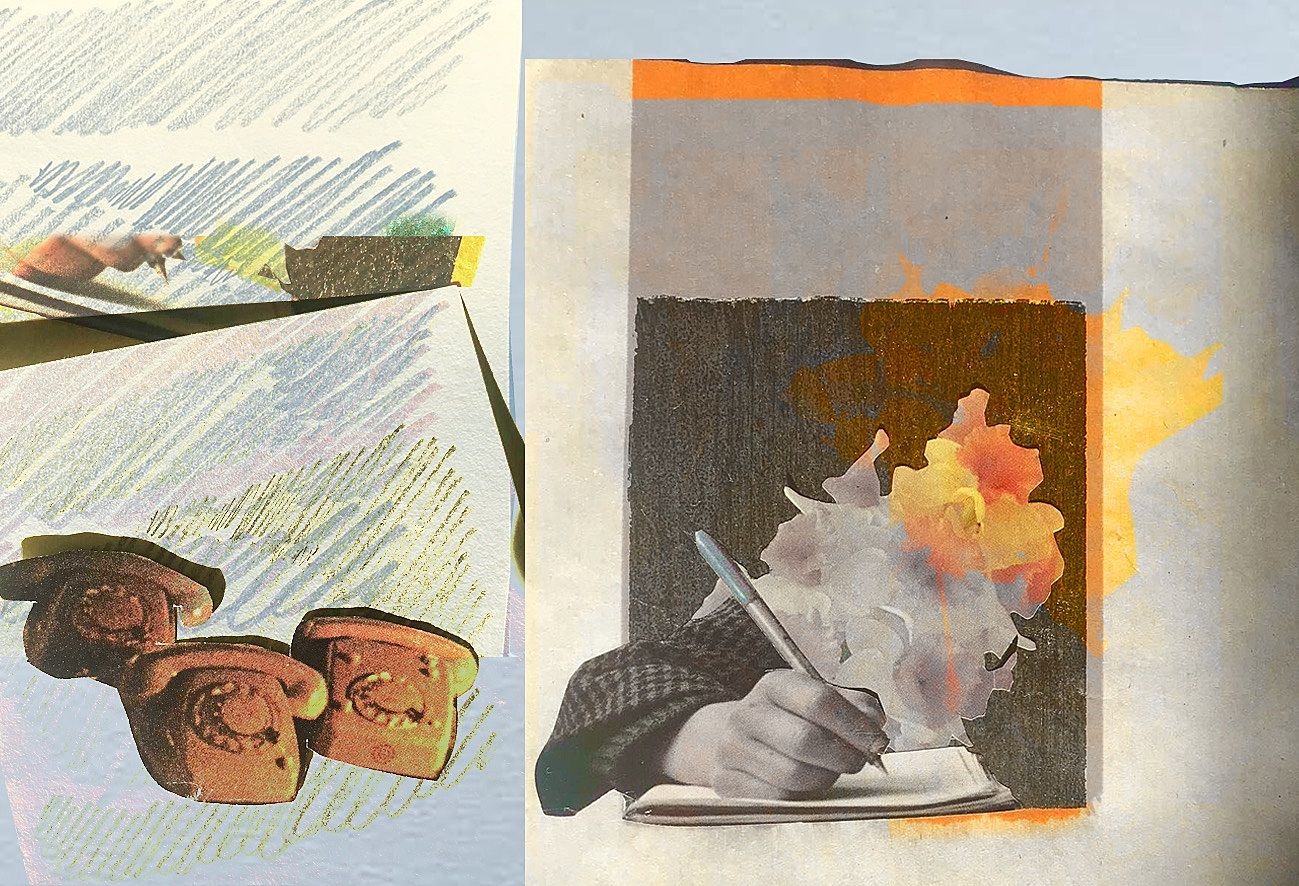Have You Heard This One?: New Zealand Writers on Tension
In a three-part series, New Zealand writers tell us how they use different aspects of craft in their writing. In this final installment: Tension.
In the final installment of our three-part series, New Zealand writers tell us how they use tension in their writing (read the other installments: voice and lyricism).
Tension can be loosely defined as the measure of strain or pull between two things, such as the tension between the thread and needle on a sewing maching, or the tension between expectation and the desire for release when watching a horror movie. We asked each writer how they use tension in their work – in essence a peek inside their toolbox. Here’s what they said.
Helen Rickerby
Bryan Walpert
Sarah Jane Barnett
Antony Millen
Chris Tse
Helen Rickerby
I think of tension in a poem as a bit like tension in knitting. Little stitches holding the fabric of the poem together. Some of the stitches I use in poetry are line breaks – which can work a bit like corset laces, tightening, stretching – internal rhyme and other repeating patterns like alliteration or repeated ideas or phrases. Other poets use pre-existing forms, such as villanelles or sonnets, or use syllabics or rhyme or strict metre.
I’m increasingly drawn to writing (and reading) long poems. Sylvia Plath said: ‘If a poem is concentrated, a closed fist, then a novel is relaxed and expansive – an open hand’. I think the same can be said of a long poem – it has a looser tension than a short poem. A long poem has more air, you can relax into it, flow along with it. Less urgency. More breathing. Tension isn’t always the same as tautness.
Sometimes long narrative poems (and shorter ones for that matter) have the narrative tension of what will happen next, as fiction does – though, for myself, when both reading and writing, I’m less interested in plot than in character or meaning. I often enjoy meandering, attention to small things. I’m thinking of Paterson (the movie rather than William Carlos Williams’s poem to which it alludes), the way it meanders through small things. The most tense thing that happens is that a dog eats a poetry manuscript (though, that could actually be pretty devastating).
One of my recent long poems, ‘How to Live’, is partly made up of the cannibalised fragments of poems that, it seemed to me, had failed, but which I felt had something. I decided to pull out the bits that I liked and wove them in with new text, including quotations. I didn’t want it to be a straightforward narrative, but more associative. I had a technical breakthrough after reading Lyn Hejinian’s My Life, which is made up of sentences that don’t really follow on from each other. It got me excited about embracing the tension of inexplicability, but I also wanted to maintain some kind of threads through it to hold it together – to return to the knitting metaphor, stitches of episodic narrative and recurring ideas and questions, including ‘What is poetry?’, ‘What is metaphor?’, and ‘How should I live?’. (Definitive answers not provided)
Lately in my work I’ve been exploring the tension between ‘opposites’. For example, between fiction and non-fiction, poetry and prose, biography and autobiography, lyricism and plain-speaking – that can lead to interesting and new ideas, effects, ways of saying something. For example, in a recent long biographical prose poem ‘George Eliot: A Life’, I take the tension of a form: the numbered paragraphs of a technical report, and push against the order of that with lyricism, digression, contradictions and personal asides.
The more I think about it, the more I find tension in many characteristics of poetry. The tension of surface and what is beneath. Of ambiguity, of subtext, of metatext. Metaphor has a tension – saying one thing is another thing, when clearly it isn’t. Poetry doesn’t have to explain, it doesn’t have to be clear. I find this a bit contradictory in myself: much of my paid work is as an editor with a strong plain-language bent, but in poetry (and other art forms too) I appreciate the ambiguity, the unsaid, the contradiction.
Bryan Walpert
One definition of which, according to my dictionary, is 'a balancing of forces or elements in opposition.' While frictionless agreement is incredibly useful (though in my experience all too rare) when groups are deciding on a restaurant or a Netflix film, it is rather less so in a poem. Tension is a term tied to New Criticism, so is out of fashion in some quarters, but it is precisely the lack of tension in our views on the world – a tension that develops from an acknowledgement of the impossible-to-fully-plumb complexity of any given person, thing, event, or piece of language – that leads to sentimentality (or an unduly hip, ironic pose) in the first place: The reason the emotion seems over the top (or stunted) is because things aren’t as simple as the voice of that poem would like to make it. One might say that sentimentality is the subservience of substance to style – of examination to exclamation. The problem with irony presents itself in the other direction. Either way, you can tell when the poet doth protest too much.
If tension is useful within a poem, e.g. between two sentiments or points of view, it is also useful when there is tension between poet and speaker, as is the case of the ventriloquist and his dummy. Duffy’s 'dummy' describes its ventriloquist as 'Balancing me with your hand up my back, listening / to the voice you gave me croaking for truth.' Croaking – that is, seeking, trying, not quite articulating. A ventriloquist often has multiple dummies. It is the multiplicity of voices that provides for the search for truth (replace 'truth' with 'meaning' if you prefer) and why the displacement of voice from self is so useful. Hence oracles of old, e.g. Delphi, in which a priestess gives advice and wisdom, but only as the mouthpiece of a god and while in an ecstatic state – ecstatic coming from a Greek word that suggested displacement of the self.
The critic David Goldblatt sees ventriloquism not as some low-brow form of entertainment but as traceable to just such an ecstatic tradition in art. The oracle nature of poetry has not disappeared: It is one’s own voice coming back estranged. Or, as Cole Swensen puts it in her poem 'What the Ventriloquists said': 'Behind a finely painted sheet of shell / a voice unlatched surrounds the world.' Which is why when I encounter poems – sometimes they’re my own – that seem too invested not just in expression but in withholding it, I find myself repeating the words of Duffy’s dummy, which like all of our creations has something to teach us: 'You can do better than that, can’t you?'
Sarah Jane Barnett
When I think about tension in poetry, I think about the work of American poet Robert Hass. To be fair, when I think about anything to do with poetry I think of Hass because I spent three years studying his work, and even after that slog his poems still make me lie down. The poem that comes to mind in terms of tension is ‘Consciousness’ from Hass's Pulitzer Prize winning collection, Time and Materials. The poem opens with Hass imagining his first moments of consciousness:
First image is blue sky, nothing in it, and not
understood as sky, a field of blue.
The second image is auditory: the moan of a foghorn.
From there, the poem describes Hass arguing with his family about ‘the nature of consciousness,’ from it being a ‘knock-knock joke’ to ‘an echo.’ Eventually he states: ‘My mind went seven places at once.’
Reading this poem, I am reminded of a game I played last weekend with my son. We made a paper cup telephone – remember those? We pierced a hole in the end of two cups with a knitting needle. I held out a length of wool and he, awkwardly working the scissors with both hands, cut it from the ball. We attached an end to each cup. I went outside; my son ran to his bedroom and hung my end of the telephone out the window. I put it to my ear.
Hass’s poem continues by describing the seven places his mind goes: ‘a line of ridge somewhere in a dry Western landscape’; ‘Whitman’; his father’s ‘quick hostility’ and advice to his young son that ‘it’s a dog-eat-dog world’; the ‘love and anger and dismay’ the poet feels when his father dies; ‘Paris’; and ‘the roof of the house’ in San Francisco where his family would place his crib as baby. It’s an enactment of the way the mind moves between and connects seemingly unrelated moments, or, another way to look at it, as Hass describing his own experience of consciousness.
The phone out the window, my son and I took turns whispering to each other. When the wool was taut our voices vibrated down the line; when the line was slack, they wouldn’t carry. If we pulled too hard, the wool popped from the cups. This is how I see tension working in poetry – that most poems, or at least the ones I respond to, open with a proposition of some kind, whether an image, emotion or thought, and hold that idea with perfect tautness through to the poem’s final transformative moment. For me, tension is what makes poetry so satisfying – the ‘ah’ at the end when I connect across time and space with another person; the voice sounding clearly from the cup.
This, among other things, is what Hass does with ‘Consciousness.’ He opens the poem trying to understand consciousness (which I also read as identity), and then as the poem progresses, the consciousness of his father. Twenty stanzas later he offers this conclusion:
It was years before I understood that my father was telling his
young son that he hated the job he had to go to every day.
It’s hard to see what you’re seeing with, to see what being is as an
activity through the instrument of whatever-it-is we have being in.
Consciousness, “that means nothing,” Czeslaw wrote. “That loves
itself,” George Oppen wrote. My poor father.
Antony Millen
Have you heard this one?
The past, the present, and the future walked into a bar.
It was tense.
Set up and punchline. The bow is drawn and then loosed. A joke relies on tension to elicit laughter. So does a horror movie trying to earn screams, or a novel wanting to collect tears on its final pages as a hero returns home victorious or empty-handed.
Constructing tension is both the most natural and most artificial thing a writer can do. In its simplest form, tension is built on fundamental questions: ‘What will happen next?’ ‘Who did it?’ ‘Why did they do it?’
More complicated questions might include: ‘How can our heroes succeed after everything they’ve experienced and considering the obstacles stacked against them?’ or ‘Will this story validate or threaten my world view?’
These questions must be placed in the reader’s mind by the writer. That sounds manipulative, but that’s OK, because the reader wants the writer to do this. The reader wants to laugh, wants to be scared, wants to be moved in thought and feeling, and they are willing to work through the pages of tension leading towards the payoff for these.
Another key element of constructing tension is the potential for conflict. Nothing should be easy—conversations, investigations, escapes, relationships—all must have some aspect of conflict or uncertainty. That doesn’t mean stringing together an endless series of spats. Even war stories need plenty of spaces without fighting. Nor should there be conflict for conflict’s sake. The arguments and failures should matter, the stakes should be important to the story and to the characters the reader cares about. There should be a sense of rising and falling, of ebbs and flows, but over the course of the story, there should also be a sense of escalation, a heightening of tension as the biggest questions near resolution.
However, no reader wants this done superficially or formulaically. Even in genre fiction, where general rules must be followed, readers want some fresh spin on these. Otherwise, there is no tension, only predictability.
They want surprises, but not ones that are unfair or telegraphed. It’s unfair when the writer relies on deus ex machina, extracting the protagonist from an impossible situation. It’s also unfair if the reader does not see the resolution coming. As surprising as it may be, they should always be able to point to earlier events and say, ‘Ah, I get it now. That’s why such-and-such happened’. At the same time, telegraphing or making the resolution too obvious ruins the surprise and no tension is created at all.
For me, foreshadowing is the key that links these aspects of questions and conflict. We were schooled in foreshadowing as teenage English students, but writing it is more challenging than we knew. Dropping hints raises those questions in readers’ minds and can be used to set the stage for conflicts.
If the hints are subtle enough, they won’t give away the ending. If they are memorable enough, readers can point at them with a laugh/scream/cry and a wink at the writer, and with great relief, say, ‘Now I see what you did there!’
Chris Tse
Some of the most affecting – and, to some extent, tense – poetry I’ve read has been when a poet has led me into the most intimate spaces of their worlds. This intimacy places great pressure on me as a reader – at times I have become a confidant, an accessory, or an unwilling witness. After all, there is a thrill to being let in on a secret or confession, or hearing someone articulate thoughts that you yourself have kept buried.
One of my all-time favourite poems is Richard Siken’s ‘Saying Your Names’ from his collection Crush. Both the poem and Crush are good examples of how poets, especially those working within the confessional space, can create tension through the use of intimacy. In his poem, Siken uses a form of repetition to explore the power that names can give to define or represent the many moments that make up a relationship. The poem begins as a list of names:
Chemical names, bird names, names of fire
and flight and snow, baby names, paint names,
delicate names like bones in the body…
As the many names pile up, Siken begins to extrapolate deeper meaning and intensity from this strange taxonomy, veering from the simple act of listing names into less certain terrain, where the names begin to shed their safety, no longer commemorating the relationship but revealing the things that threatened it:
I’ll use my body like a ladder, climbing
to the thing behind it, saying farewell to flesh,
farewell to everything caught underfoot
and flattened. Names of poisons, names of
handguns, names of places we’ve been
together, names of people we’d be together.
Reading this poem always makes me feel like I’m in the front row watching the undoing of the memories that have made up a relationship, and the pain that comes from accepting that one has to let go of something in order to move on. The pressure that Siken creates in this poem is unrelenting, and he makes it difficult to look away (it can compel the reader to press forward, hoping for that sweet release). The intimacy of the poem places the weight of voyeurism and complicity upon the reader, making us a party to the speaker’s emotional breakdown. The poem culminates in a stark plea: “I just don’t want to die anymore.”
As readers, we expect such tension to result in some kind of cathartic release, but to withhold that release from a reader – whether it’s a moment of shock or slow-burning realisation – can amplify the desired effect. Think about the adrenaline rush of watching a horror film and the techniques used to set up every jump and plot twist. We suffer through them just to get to that final moment of (supposed) safety. In Siken’s poem, the catharsis isn’t so much a release than it is a sucker punch. There is no happy ending; there is no resolution.
In How to be Dead in a Year of Snakes, I wanted to create a similar tension by offering the reader multiple voices from which to approach the events of the book. My aim was for strained connections between the many characters and voices of the book to pull the reader in multiple directions, using the intimacy that each voice provides to disorientate and challenge the reader. By allowing the reader to peek into these characters’ thoughts, I was able to not only immerse the reader in the world of the book, but to make them a part of this horrifying act.
The feature photo Head on bike crash by Anders Lejczak is used under a Creative Commons CC-BY License.
Read the other installments in this series: Voice and Lyricism.






